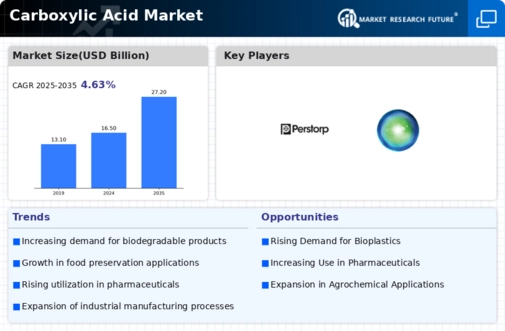Top Industry Leaders in the Carboxylic Acid Market
 Carboxylic acids, organic compounds essential in diverse industries, paint a vibrant picture of a dynamic market. This market is characterized by a fierce competition among established players and emerging contenders, all vying for a larger slice of the pie. Understanding the strategies employed, factors influencing market share, and recent developments is crucial for navigating this dynamic landscape.
Carboxylic acids, organic compounds essential in diverse industries, paint a vibrant picture of a dynamic market. This market is characterized by a fierce competition among established players and emerging contenders, all vying for a larger slice of the pie. Understanding the strategies employed, factors influencing market share, and recent developments is crucial for navigating this dynamic landscape.
Market Strategies:
1. Diversification and Innovation: Recognizing the vast applications of carboxylic acids, companies are expanding their product portfolios. BASF, for instance, recently launched a new range of acetic acid derivatives for the pharmaceutical industry. Additionally, research and development efforts are focused on sustainable production methods and bio-based alternatives, catering to the growing eco-conscious consumer base.
2. Geographical Expansion: Emerging economies in Asia-Pacific and Latin America present lucrative opportunities for market expansion. Leading players like Eastman Chemical Company are establishing new production facilities in these regions to cater to the rising demand.
3. Strategic Alliances and Acquisitions: Collaborations and mergers are accelerating, allowing companies to leverage complementary strengths, access new markets, and optimize production processes. The recent acquisition of Perstorp's industrial acids business by SK Chemicals is a prime example of this trend.
4. Vertical Integration: To gain greater control over the supply chain and enhance profitability, companies are pursuing vertical integration strategies. ExxonMobil's expansion into downstream markets for acetic acid derivatives showcases this approach.
Factors Influencing Market Share:
1. Product Portfolio and Quality: Offering a diverse range of high-quality products catering to specific needs is crucial for gaining market share. Companies like Lanxess are renowned for their focus on purity and stringent quality control measures.
2. Cost-Effectiveness and Efficiency: Optimizing production processes and maintaining cost-competitiveness are critical for surviving in this price-sensitive market. Dow Chemical's focus on operational efficiency and large-scale production facilities puts them at an advantage.
3. Sustainability and Environmental Concerns: The growing emphasis on green practices and responsible sourcing is influencing consumer choices. Companies like Celanese Corporation are investing in bio-based carboxylic acid production, positioning themselves as environmentally conscious players.
4. Regional Demand and Regulatory Landscape: Understanding regional demand trends and navigating complex regulatory environments is essential for success. Companies like Sasol are adept at adapting their product offerings and production processes to comply with regional regulations.
Key Companies in the carboxylic acid market include
- BASF SE (Germany)
- Eastman Chemical Company (US)
- Dow (US)
- Jiangsu SOPO (Group) Co. Ltd (China)
- FINETECH INDUSTRY LIMITED (UK)
- Celanese Corporation (US)
- Perstorp (Sweden)
- Alfa Aesar (US)
- LyondellBasell Industries Holdings B.V. (US)
- OXEA GmbH (Germany)
- Snowco industrial Co. Ltd (China)
- Blue Marble Biomaterials (US)
- Hydrite Chemical (US)
- Pacific Oleochemicals Sdn Bhd (Malaysia)
Recent Developments:
-
October 2023: ExxonMobil reports record profits from its acetic acid derivatives business, driven by strong demand in the Asia-Pacific region. -
November 2023: The European Union imposes stricter regulations on the use of certain carboxylic acids in food production, impacting market dynamics. -
December 2023: Eastman Chemical Company acquires a smaller competitor, strengthening its position in the North American acetic acid market. -
January 2024: Celanese Corporation announces a breakthrough in the production of bio-based propionic acid, a promising alternative to petrochemical-derived options.

